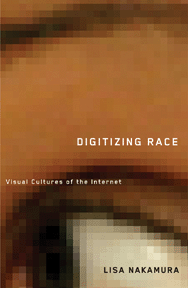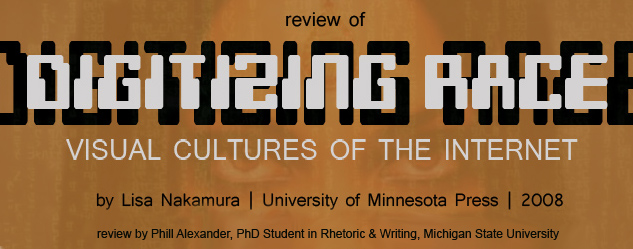

Introduction:
Digital Racial Formations
Chapter 1:
"Ramadan is Almoast Here"
Chapter 2:
Alllooksame
Chapter 3:
The Social Optics of Race
Chapter 4:
Avatars and Visual Culture
Chapter 5:
Measuring Race on the Internet
Epilogue:
Racio-Visual Logic
Conclusions on Digitizing Race
Internet bulletin board posts created by female Internet users can work to decenter medical authority.... (p. 132) Nakamura makes a clever rhetorical move/connection in chapter 4 by centering her discussion of embodiment on the Internet on pregnant women (a profoundly and inescapably embodied condition) and their discussion forums. She does this specifically by discussing “reborn” dolls (a craft practice in which a generic doll body is purchased, customized, and often resold on eBay) and the DIY movement as a parallel to avatar and signature creation (see Figure 1 below), particularly through a website called “Beaner Dreamers,” which provides avatar doll templates.
This chapter’s focus on representation through avatars and signatures is refreshing; while the Internet itself is moving quickly away from the message board as a standard, myriad communities still exist based primarily—if not solely—on such forums. Scholars in visual and digital rhetoric barely explored the powerful collaborative and individualized nature of these environments years ago, and Nakamura’s model here will no doubt be of use to others who look to do similar work. Looking specifically at pregnancy—a condition that Nakamura reminds readers is highly and inescapably embodied—adds an element that is often missing from the existing scholarship about digital identity representation. The women on these forums are highly invested in this embodied change, and as such they are also invested in their avatars and signatures reflecting this change. This, of course, runs counter to the once dominant belief that the digital is disembodied, and I believe Nakamura’s careful work to tie the physical body to the digital representation of that body is a challenge to other scholars of digital identity. It’s a challenge I hope the field will accept. As a reviewer, I must include an aside here; Nakamura does amazing work throughout this book to recognize the use of racial stereotypes, and she explains in text that “Beaner” in this case is derived from the fact that pregnant and hoping-to-conceive women refer to babies/fetuses as “beans” in these communities, but as a current student of American cultural rhetoric, I would have greatly appreciated a recognition of the fact that “beaner” is also a common derogatory slander for Mexican immigrants and Chicanos in general (refuted most famously by the comedian Carlos Mencia, who bases many of his jokes around the word as self-referential reclamation). Given the primacy placed on race in this text, the fact that “Beaner” is included—along with a discussion of the Beaner Dreamer dolls that appear to be Latino—with no mention of the word’s other connotations strikes me as a strange decision, though I am certain that Nakamura had reasons to not dwell (perhaps because to do so would have, like this interjection, greatly disrupted the flow of ideas, though again I would argue that sometimes we need to tolerate such disruptions due to the high value of calling attention to embedded instances of racism we might otherwise miss).
|
